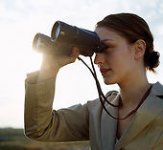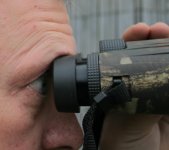As others have said, it depends on your physiology. Having symetrical features helps since it will enable you to keep both eyes centered in the exit pupils. Going a bit off center is what can cause image blackouts. I noticed that since I bought a new pair of eyecups for my 8x32 SE, I'm more suspetible to blackouts. Before that, the slight flaring of the eyecups (which is caused by me having to dig the wide eyecups in between my rhinoproboscis) put my eyes at a slightly farther distance from the EPs and minimized blackouts.
You can experience image blackouts with SE by either not having your eyes centered or by being too close to the EPs or by having your eyes at the wrong angle. Those who say they have no problems with the SE so you will have no problems aren't correct. You won't know until you try one yourself since your facial features are unique to you.
Even though they all share the same EPs, I have more issues with the 8x32 than the 10x42 and 12x50, I think because I use the 8x32 at closer distances, which requires resetting the IPD. When I'm in a rush to "get on a bird" quickly, I don't always take the time to make sure the view is a perfect circle.
With the 10x42 SE, I'm generally "looking long," so I rarely reset the IPD, and since I used the 12x50 for stargazing, I never reset the IPD.
There's also a technique I've named MOLCET that suprisingly nobody's mentioned that can help you stop the blackouts.
Below are some photos of what this looks like, but basically, you rest the top of the eyecups on your eyebrows and tilt the binoculars slightly upward. Perhaps its inventors mooreorless and ceasar will elaborate further (and so Bob can tell you that he has no trouble with blackouts with his Kahles binoculars, shown in the second photo

.
The view of the SE is fabulouso, and considering what alpha roofs and even second tier roofs cost these days, the SEs still provide the best bang for your buck in premium optics, so they are worth trying. The 12x50 SE is my favorite held held astro bin, the 8x32 SE, my second favorite birding bin (after the 8x30 EII). I really liked the 10x42 SE, too, but it was too lightweight for my shaky hands, at least for daytime use. With the weight back on my face, the 10x an 12x could be held steady enough for casual stargazing, but for best results with stargazing, mounting is always the best method.
Brock






